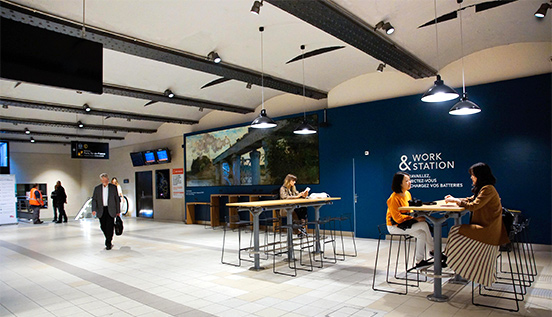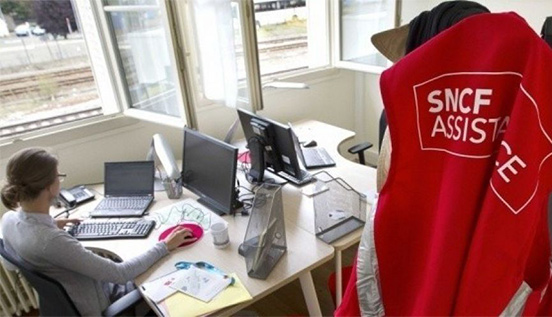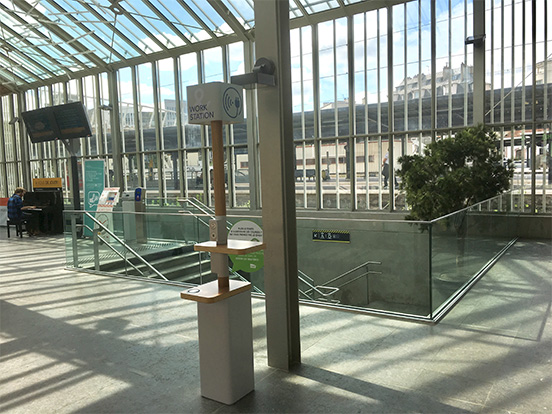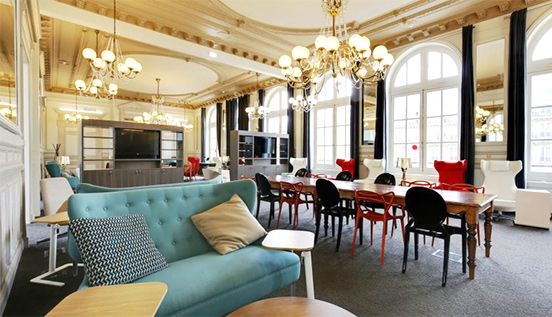[Workstyle Reforms in France (1)] A State-owned Railway Company Trying to Reduce Commuting Stress that is On Par with Tokyo
SNCF (Société Nationale des Chemins de Fer Français, French National Railway Company)

(Photo provided by SNCF)
Of the western countries, France has one of the largest numbers of office workers who commute by train. People who moved to the suburbs from Paris, where land prices have continued to rise in recent years, are having to commute longer and their commute trains into Paris have become more congested. The resulting increase in commuting stress becoming a social problem.
Telework has been a realistic way to solve this issue, and the government has been accelerating its initiatives in supporting telework especially since the revision of the labor law in 2017. On the other hand, French companies are traditionally more controlling over their employees and a culture of placing importance on being present at the workplace is hindering the spread of telework.
Under such an environment, which has a lot in common with Japan, the efforts of French companies to reform workstyles should be inspiring to Japanese companies. In this series we will introduce interviews on workstyles in France.
A conservative corporate culture and resistance of employees
SNCF became state-owned in 1937 and was turned into an EPIC (établissement public à caractère industriel et commercial (literally translating to "public establishment of an industrial and commercial nature)), a type of public enterprise in 1983 but has not become fully privatized. It currently operates in 120 countries around the world, with 33% of its annual sales of 33.3 billion euros generated from the overseas business. It is one of the largest companies in France, with the number of passengers, both in France and abroad, amounting to an average of 149,000 per day, and employees totaling 270,000, including those in the overseas business.
SNCF has been making various efforts since 2006 to provide a comfortable work environment to its employees. As part of such efforts, it introduced telework in 2009 and started offering telework space not only to its employees but also potentially to its passengers in 2012. Today, SNCF aims to promote flexible work by developing co-working spaces using the land and buildings—mainly railway stations—that it owns.
However, its path to workstyle reforms was not an easy one. Although it is transforming itself in proportion to the internationalization of business, the culture of the former state-owned company is old, and conservative concepts such as promotion by seniority and life employment are still common. Introducing new workstyles such as telework was met with a lot of resistance. One of the reasons to this was that a serious lack of employees during the 1920s when private transportation companies operated in each region led to the provision of exceptionally preferential treatment to railway personnel in order to attract many people. For example, life employment was taken for granted, several weeks of holidays were given to those who worked overtime, medical costs were free, employees were allowed to live in housings attached to the stations, and free train fare was granted even after retirement. Such special treatment that is unthinkable in today’s labor market created a conservative corporate culture and resulted in strong resistance by the employees who feared they would lose their privileges due to the reforms.
It happens that, as of January 2020, France is in the midst of an indefinite strike against the pension reform plans by the government. The strike has been carried out on a large scale mainly in public transport, including SNCF, with 90% of the trains in operation cancelled.
“It is very sarcastic that an SNCF employee should say this, but demand for telework rises significantly all over France, including within SNCF, when means of transport is disrupted by a strike. I think we should consider this situation as an opportunity and promote telework.” (Antoine Martin, head of the co-working space program, SNCF)
Team members gather at the office at least once a week even after introduction of telework
The introduction of telework at SNCF started off as a way to reduce commuting stress of mainly its employees living in the suburbs of Paris. Upon introduction, SNCF carried out enlightenment activities within the company such as notifying its employees of the advantages of telework through newsletters and promotional videos. However, when it conducted a major questionnaire survey on telework in 2016, many of its employees replied that although they wished to telework they were hesitant toward its actual introduction. It was also revealed that many of its employees had given up on applying for telework from concerns that being out of the office for a long time would lead to lower assessment and hinder future promotion.
Applications for telework rose significantly after a law concerning telework was enforced in 2012, but this time the management side resisted. Since the general idea of management had been based on visual confirmation, managers were perplexed with the new way of management that was based on results. In order to cope with such problems, SNCF has been enhancing their follow-ups on managers and is focusing on establishing a system where managers can accept their new role as “facilitator of projects,” instead of as “manager of employees.” Although the idea of presentism is still strongly rooted in France, the trust relationship between managers and team members as well as the mindset of individuals are gradually changing with the spread of new workstyles, and the country is entering a paradigm shift. Furthermore, the situation is also changing as the young generation (X and Y Generations) with completely views toward workstyles has entered the market.
“In France, the law recognizes telework as a right of employees. However, managers should not accept their team members’ application for telework just because the law recognizes it. Employee management works even after introducing telework because there is a trust relationship between managers and team members. Unless there is a trust relationship between managers and team members, telework will end in failure with or without the law.” (Catherine Priol, head of station redevelopment, SNCF)
The request of employees is reflected in terms of the day of the week when they can telework, but what is important is that there is at least one day in the week when all team members gather at the office. Since a lot of communication is required at Ms. Priol’s department, all team members come to the office twice a week—every Monday and one other day—to hold important meetings. Meanwhile, most of her team members telework from home on Fridays, which is considered the day for telework.
At SNCF, 3,500 or 2.4% of its total employees of 149,000 officially telework (as of 2018). The telework introduction rate is lower than the national average (8,5%), but this can be attributed to the fact that many of its employees are engaged in work that cannot be done through telework.
“Even if there was a wonderful work environment with a new company building and so on, telework is still useful as it can reduce commuting stress. When we telework, we carry out work that requires concentration, such as writing reports, replying to emails, and creating contracts. When we come to the office, we focus on communication between team members. I feel that such balance of work has improved work productivity a great deal. ” (Antoine Martin)
Suburban co-working spaces for employees who cannot work at home

Railway tracks can be seen outside the window. (Photo provided by SNCF)
Bi Localisé is a co-working space project for employees that SNCF has been carrying out since 2012 to achieve the purpose of telework: reducing commute stress. In this project, SNCF has established co-working spaces in the spare space within its buildings and railway stations and provides them as a telework space for employees living nearby. For example, many SNCF employees live near Rambouillet, which is located 80 kilometers from Paris, and most of them commute by car since public transport access is not good. In order to alleviate commuting stress, such as traffic jams in the mornings, about 20 employees telework on a daily basis at a Bi Localisé located inside Rambouillet station. With 10 Bi Localisés provided in major stations, etc. in the suburbs of Paris, employees living nearby have been able to work without having to commute to Paris every day.
Bi Localisé, which started during a trial period before full introduction of telework at SNCF, is positioned as the third place, between working from home and working at the office. At SNCF, employees are required to meet certain rules concerning the work environment when they telework from home, and employees with small children or without a safe Internet environment, for example, are not allowed to telework. Bi Localisé was accepted by such employees as a means of providing an environment that was convenient for commuting and suitable for work at the same time.
Reducing congestion on trains with Work & Station, a co-working space for passengers and other users


(Photo provided by SNCF)
Following the success of Bi Localisé, a co-working space for SNCF employees, the company started providing co-working space for outside users in 2016. This project, which was named Work & Station, is a railway company’s effort for solving France’s social problem of congestion on trains during the rush hour.
Express trains running in the suburbs of Paris, which are used for commute by many workers, are frequently delayed, causing not only physical stress due to congestion but also mental stress of not knowing how long the commute will take each day. Co-working spaces established within the stations are currently being used by a wide variety of people, including those who were stranded due to train accidents and those who try staggered commuting to avoid the commute rush.
There are currently four types of Work & Station, which are based on the space within the station they are established in, or the characteristics and customer base of the area. The ‘micro-co-working’ type, which offers free usage and is the smallest of the four types, is like a waiting room in the station and is established in more than half of the stations in Greater Paris. It is equipped with Wi-Fi, power source for PCs, and beverage vending machines. The average dwell time is short, around 15 to 30 minutes.
The largest type is called ‘business center.’ Many of SNCF’s major stations (terminal stations for TGV) are historical buildings with vast unused spaces. Since 2016, SNCF has been providing large-scale co-working spaces in these spaces. Its main targets are busy business persons who cannot even afford the time to go out from the station into the city of Paris. They appreciate these spaces, which allow them to meet with their clients inside the station. The interior design places emphasis on luxuriousness to match the buildings and usage fees are more expensive than other types. Operation is outsourced to major co-working space operators such as Regus and Multiburo.

There is also a type that is between micro-co-working and business centers. They co-working spaces being built in former station master’s quarters within major railway stations around Greater Paris or on sites owned by SNCF near the stations (which used to be parking lots or space for distribution services). They are also a project launched to reduce the commute rush. The intended users include self-employed persons and start-ups, while there are many cases where companies have signed up to enable their employees to work near their homes. The first location is scheduled to open in early 2020, with an additional two that are under construction scheduled to open some time in 2020. About 10 more are in the planning stage.
This is the end of Part 1. In Part 2, we will introduce the efforts of SNCF, which is working not only in reducing commuting stress with new workspaces but also in missions such as revitalizing communities and supporting entrepreneurship.

